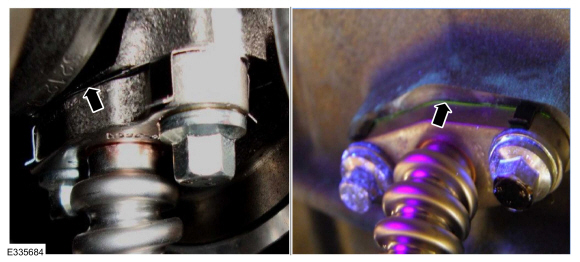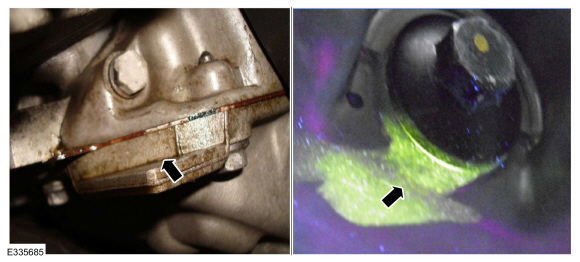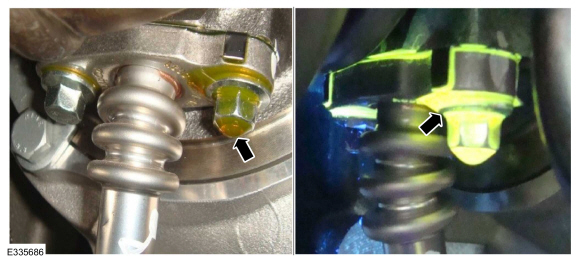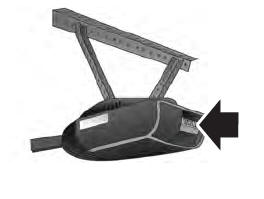Lincoln Nautilus: Engine System - General Information / Oil Leak Inspection - Gasoline. General Procedures
Lincoln Nautilus 2018-2025 Service Manual / Powertrain / Engine / Engine System - General Information / Oil Leak Inspection - Gasoline. General Procedures
NOTE: If an overnight drive is done, the fan air or road air blast can cause erroneous readings.
NOTE: When diagnosing engine oil leaks, the source and location of the leak must be positively identified prior to repair.
-
Prior to carrying out this procedure, clean the cylinder
block, cylinder heads, valve covers, oil pan and flywheel/flexplate with
a suitable solvent to remove all traces of oil.
Engine Oil Leaks - Fluorescent Oil Additive Method
NOTE: If the factory fill engine oil with dye is present, change the engine oil and the oil filter prior to using the Dye-Lite® Oil-Based Fluid Dye (164-TP33200601).
-
Some fluid leaks are acceptable and considered
characteristic of the component seal depending on the component, system
or fluid it seals. These are called a weep or a seep.
-
Weep(s): A weep is detected under black light inspection
demonstrating a continuous yellow (die color) trace at the gasket joint
or seal surface and characterized by no detection of oil under white
light inspection. A weep is incidental and not acceptable for fuel,
brake or transmission lines. Weeps are acceptable for all other areas.
 |
-
Seep(s): A seep is considered a more pronounced weep but
not enough to result in dripping. When wiped off, the moistness should
not reoccur before renewed operation. A seep is oil detected under black
light inspection and characterized by oil detection under white light
inspection resulting in staining at the sealing and the adjacent flange.
A seep is not acceptable for fuel, brake or transmission lines, in
visible areas under hood or under vehicle. Seeps are acceptable around
engine ventilation components such as PCV components and oil fill caps.
 |
-
Leak(s): A leak is oil detected under black light
inspection and characterized by oil detection under white light
inspection resulting in accumulation of oil drops and/or pooling. All
leaks are considered unacceptable
 |
-
Use the UV Long-Wave W/12-foot Cord & Alligator
Clips (164-R3748) or Leak Tracker UV-LED Leak Detection Flashlight
(164-TP8695) to carry out the following procedure for oil leak
diagnosis.
-
Add 29.6 ml (1 oz) of Dye-Lite® Oil-Based Fluid Dye
(164-TP33200601) to a minimum of 0.47L (1/2 qt) and a maximum of 0.95L
(1 qt) engine oil. Thoroughly premix the oil based fluid dye or it will
not have enough time to reach the crankcase, oil galleries and seal
surfaces during this particular 15 minute test. The additive must be
added through the oil fill. Check the level on the oil level indicator
to determine what amount of oil to premix. If it is in the middle of the
crosshatch area or below the full mark, use 0.95L (1 qt). If it is at
the full mark, use 0.47L (1/2 qt).
-
NOTE: For best results allow the customer to drive the vehicle for a day.
Run the engine for 15 minutes. Stop the engine and inspect all seal and gasket areas for leaks using the UV Leak Detector Kit. A fluoresces white area will identify the leak. For extremely small leaks, several hours may be required for the leak to appear.
-
At the end of test, make sure the oil level is within
the upper and lower oil indicator marks. Remove oil as necessary if it
registers above the full mark.
 Oil Consumption Test - Gasoline. General Procedures
Oil Consumption Test - Gasoline. General Procedures
Nearly all engines consume oil, which is essential for
normal lubrication of the cylinder bore walls and pistons and rings.
Determining the level of oil consumption may require testing by
recording how much oil is being added over a given set of miles...
 Oil Pressure Test - Gasoline. General Procedures
Oil Pressure Test - Gasoline. General Procedures
Oil Pressure Test 2.7L EcoBoost & 3.3L Duratec & 5.0L Ti-VCT
NOTE:
It is necessary to disconnect the battery to avoid
setting any DTCs that could cause the PCM to command the oil pressure to
other than what should be observed from a correctly operating system
during the oil pressure test...
Other information:
Lincoln Nautilus 2018-2025 Service Manual: B-Pillar and Reinforcement. Removal and Installation
Special Tool(s) / General Equipment Resistance Spotwelding Equipment Spherical Cutter Hot Air Gun Air Body Saw 8 mm Drill Bit MIG/MAG Welding Equipment Spot Weld Drill Bit Locking Pliers Materials Name Specification Metal Bonding AdhesiveTA-1, TA-1-B, 3M™ 08115, LORD Fusor® 108B, Henkel Teroson EP 5055 - Seam SealerTA-2-B, 3M™..
Lincoln Nautilus 2018-2025 Service Manual: Cellular Phone Antenna. Removal and Installation
Removal NOTE: RH side is shown, the LH side is similar. Remove the rear bumper cover. Refer to: Rear Bumper Cover (501-19) . Remove the rivets, the pin type retainer and the cellular phone antenna. Installation To install, reverse the removal procedure. ..
Categories
- Manuals Home
- 1st Generation Nautilus Owners Manual
- 1st Generation Nautilus Service Manual
- Replacing the Rear Wiper Blades
- Switching the Lane Keeping System On and Off. Switching the Lane Keeping System Mode
- Power Outlet - Vehicles With: 110V Power Outlet
- New on site
- Most important about car
Programming the Garage Door Opener to Your Garage Door Opener Motor

Copyright © 2025 www.linautilus.com
